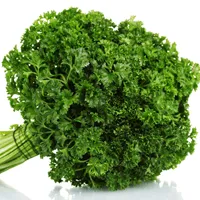
- Share on Facebook5
- Share on Pinterest
- Share on Twitter
Parsley is much more than a garnish!
 The Folklore
The Folklore
Mention of parsley traces back to the first century A.D., by such notables as the Roman scholar Pliny the Elder, who praised it as a staple in soups and salad, and the father of medicine, Hippocrates, who noted its medicinal qualities. Despite such praise, parsley has long been associated with death, probably because it looks a lot like fool’s parsley, a poisonous relative of hemlock.
The ancient Greeks, in fact, never served parsley at the table, but only wore wreaths of it, to honor the dead. Romans also wore parsley wreaths, to stave off effects of wine. For centuries, parsley has enjoyed a variety of uses as a cleansing herb, including as a breath freshener, baldness remedy, and purported treatment for kidney and bladder ailments.
The Facts
Parsley (Petroselinum crispum) is a member of the Apiaceae family along with celery, carrots and parsnips. Parsley is a small plant with either dark, flat green leaves that resemble coriander, or bright green, curly leaves. The pungent flat leaf or Italian parsley is preferred for cooking, while the curly leaf variety often is used as a garnish, but both are widely used in Mediterranean, Eastern European, and American cooking.
Just two tablespoons of parsley, high in vitamin K and the antioxidant vitamins A and C, pack 144 percent DV (DV, based on 2,000 calories per day) of vitamin K for bone and heart health.
The Findings
Along with its antioxidant vitamins, parsley contains several other unique compounds that also pack antioxidant punch. Myristicin, one of parsley’s essential oils, was shown in animal studies to have anti-inflammatory properties to inhibit tumor formation and growth, according to a 2011 study reported in Molecules.
Apigenin, one of many flavonoids in parsley, has been prevalent in recent breast cancer research, and has been shown to stop breast cancer cells from multiplying and growing, according to a study published in 2011 in Cancer Prevention Research.
The Finer Points
A sprig or even an entire bunch of parsley adds fresh color and flavor. Used as an herb, spice and vegetable, parsley is available fresh or dried year-round. Choose firm stems and vibrant green leaves with no discoloration. Refrigerate upright in a container of water, covered by a plastic bag.
Sprinkle chopped fresh parsley for a beautiful finish on most any dish, or be bold and try it in a Mediterranean green salsa served over vegetables or poultry, a classic tabouleh, or pesto tossed with whole wheat pasta.
Notable Nutrients
2 tablespoons raw parsley:
Calories: 2
Vitamin A: 12 percent Daily Value
Vitamin D: 16 percent DV
Vitamin K: 144 percent DV
Lutein plus zeaxanthin: 418 mg
RECIPE: TOMATO-CUCUMBER SALAD WITH PARSLEY AND MINT
Ingredients:
4 medium ripe tomatoes, seeded and chopped
1/2 medium cucumber, peeled, seeded and chopped
1/3 cup diced red onion
2 Tbsp fresh parsley, chopped
2 Tbsp. fresh mint, chopped
1 Tbsp. red wine vinegar
2 tsp. olive oil
1 tsp. Dijon mustard
Salt and freshly ground black pepper
Preparation:
1. In large bowl, combine tomatoes, cucumber, red onion, parsley and mint.
2. In small bowl, whisk together vinegar, oil and mustard. Add to tomato mixture and toss to coat.
3. Season to taste with salt and black pepper. Serve chilled or at room temperature.
Makes 4 servings
Nutrition information per serving: 59 calories, 3 grams fat, 8 grams carbohydrates, 2 grams protein, 2 grams dietary fiber, 45 mg sodium.
– Lori Zanteson
Recipe adapted from American Institute for Cancer Research.
Reprinted with permission from Environmental Nutrition, a monthly publication of Belvoir Media Group, LLC. 800-829-5384.www.EnvironmentalNutrition.com. (c) 2012 BELVOIR MEDIA GROUP DISTRIBUTED BY TRIBUNE MEDIA SERVICES, INC.
- Share on Facebook5
- Share on Pinterest
- Share on Twitter

